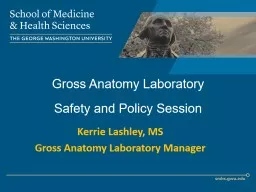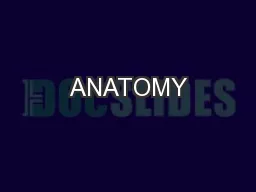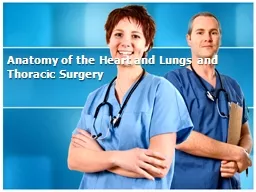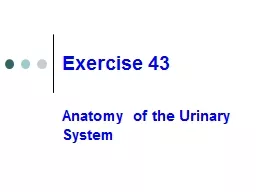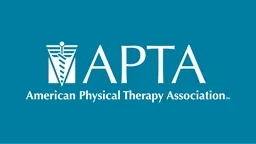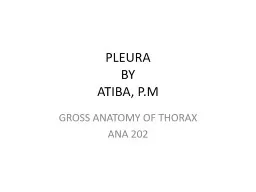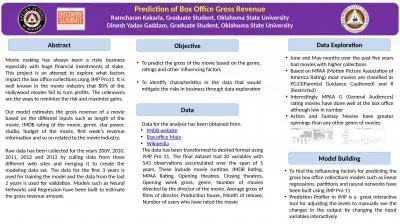PPT-Gross Anatomy Laboratory
Author : olivia-moreira | Published Date : 2019-12-15
Gross Anatomy Laboratory Safety and Policy Session Kerrie Lashley MS Gross Anatomy Laboratory Manager Learning Objectives Describe expectations concerning professional
Presentation Embed Code
Download Presentation
Download Presentation The PPT/PDF document "Gross Anatomy Laboratory" is the property of its rightful owner. Permission is granted to download and print the materials on this website for personal, non-commercial use only, and to display it on your personal computer provided you do not modify the materials and that you retain all copyright notices contained in the materials. By downloading content from our website, you accept the terms of this agreement.
Gross Anatomy Laboratory: Transcript
Gross Anatomy Laboratory Safety and Policy Session Kerrie Lashley MS Gross Anatomy Laboratory Manager Learning Objectives Describe expectations concerning professional conduct in the Gross Anatomy Laboratory. 08/08-09/11. “ You are in your car, and you discover a turtle lying in the middle of the road. You decide to take a closer look because you always wanted a pet turtle. The animal looks intact, but it does not appear to be moving. How do you go about determining if it is alive ?. (. Shoulder,elbow,and. wrist). . IN COMPUTED TOMOGRAPHY. Frank Cairo R.T. ( R ) ( CT ) ( MR ). General Imaging Methods. CT is a major method for the evaluation of MSK anatomy and disease; it. Provides specific information about bone and other mineralized tissue. INTRODUCTION. Anatomy deal with all branches of knowledge which are concerned with the study of body structure. It has come to mean knowledge of the form and relation of parts of the body which may be obtained by this fundamental method of study. It also includes more minute structural details which are uncovered with aid of microscope and developmental anatomy called Embryology. Thoracic Surgery. Prior to Surgery. Patient will need. SCD’s. Large bore IV/ Central line. A-Line. Bair Hugger. Positioning . Airplane. Headrest. Pillows. Vac Pac. Foley. Special Intubation needs. Anatomy of the Lungs. Syllabus. Course design. Blackboard. Grading scheme. Class rules and policies. New edition of textbook came out this fall!. (2. nd. Edition). Old edition. is okay to use. Lab Manual. (MUST PURCHASE). 2. 2. Learning Objectives. Apply the concept of realization and explain when taxpayers recognize gross income . Understand the distinctions between the various sources of income, including income from services and property. January 23, 2018. 1. Prepared and presented by. Luke Morris. Assistant Secretary. Office of Legal Affairs. Informational Purposes Only. This presentation is for informational purposes only and not to be considered advice, informal or otherwise. The material herein is informational in nature and based on publicly available data.. Functions of the kidney. Excretory. Keeps the electrolyte balance. Keeps the acid-base balance. Keeps the water balance. Gross anatomy . Kidney. The right kidney is in a lower position than the left.. Anatomy From The Inside Out: A 3D Kinesthetic Learning Method Beth Moody Jones, PT, DPT, EdD Stephanie Muth , PT, PhD Disclosure No relevant financial relationships We would like to thank Anatomy in Clay© and Thieme for their support of this program These non-GAAP financial measures are provided to enhance investors’ overall understanding of the Company’s historical operations and financial performance and, as presented, may not be comparable to similarly titled measures of other companies due to varying methods of calculation.. ANA 202. 05/04/2020. Gross Anatomy of Pleura and Lungs. 2. The pleura is refer to as the serous membranes that lines the lungs and thoracic cavity.. Each pleural cavity is lined by a single layer of flat cells, mesothelium, and an associated layer of supporting connective tissue; together, they form the pleura. . 1. cHarged 2014 Summary Talk, Eilam Gross, Weizmann. Apologies:. There were many great talks.. I have learnt a lot.. There is no way to cover it all in 30 minutes.. So I concentrated on the mutual experimentalist/theorist lessons learnt. LMU Dual Enrollment Gross Anatomy . Intro to Human Anatomy Course. 3 credit lecture and 1 credit lab course . LMU EDGE Program . Multiple online or face-to-face courses available. . How to Qualify? . Ramcharan . Kakarla, Graduate Student, Oklahoma State University. Dinesh Yadav . Gaddam. , Graduate Student, Oklahoma State University. Institution(s). Abstract. Objective. Data. Data Exploration. Model Building.
Download Document
Here is the link to download the presentation.
"Gross Anatomy Laboratory"The content belongs to its owner. You may download and print it for personal use, without modification, and keep all copyright notices. By downloading, you agree to these terms.
Related Documents

